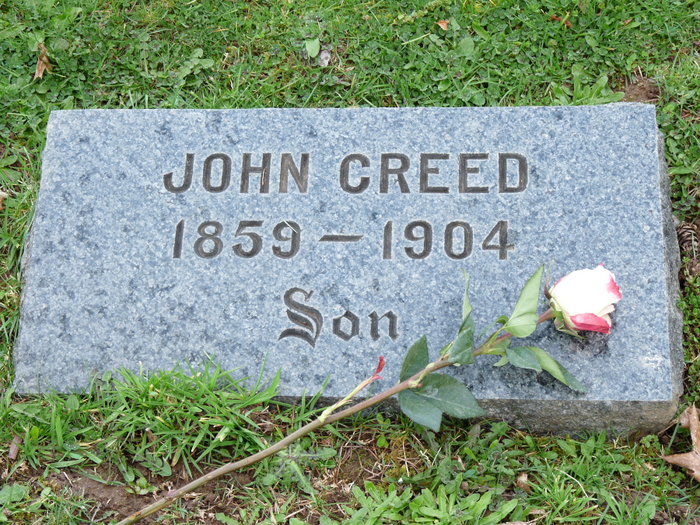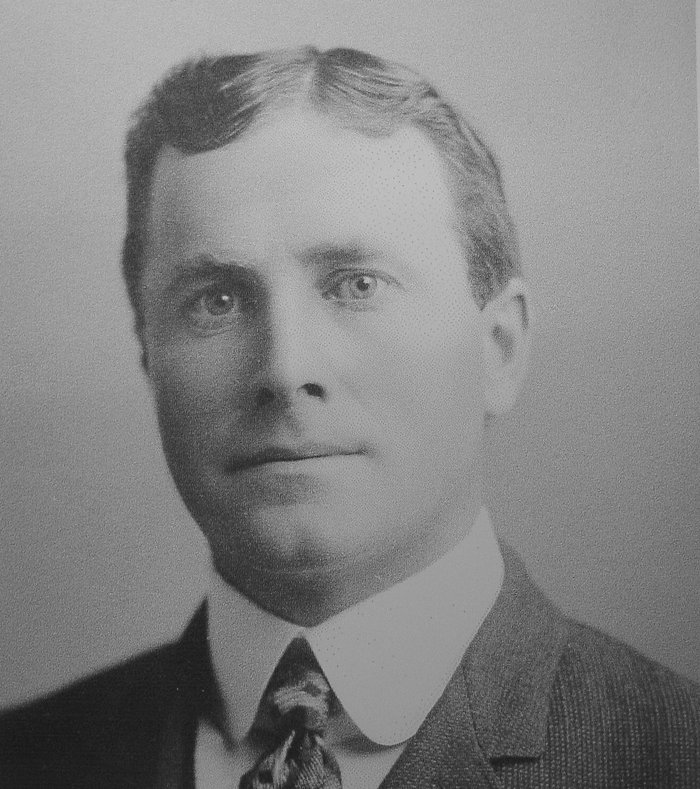He graduated from Willamette University around 1881, and soon after went to work in the mercantile store of his older brothers, George (b 1843 Indiana) and Virgil (born 1847 Indiana), established in 1882 at Paisley in Lake County, Oregon. In 1892, Creed established his own mercantile store at Silver Lake, in north Lake County. Other brothers who lived for a portion of their lives in Lake County were Harmon, Francis ‘Frank,' and Lafayette ‘Lafe.'
Creed Conn became a bit of a celebrity around central Oregon because of his very fine freight team. He owned as many as 14 animals at one time, but probably never employed all of them at once. Around 1900, tradition dictated that if a team could pass another team on a steep grade, it would win the bells of the inferior team, and Creed Conn's team had many, many bells. He had two white lead animals, that may have been horses, and the rest of the team was comprised of mules, that were probably of Percheron ancestry because his father and brother James (born 1852 Indiana) bred Percheron horses.
Creed Conn employed his lifelong friend, Thomas J. LaBrie (son of Ferdinand LaBrie of the French Settlement area) as his teamster. In the early days, the team traveled all the way from Silver Lake to The Dalles with wool, and returned with groceries. After 1900, the trip was shortened when the railhead reached Shaniko, a journey of 170 miles each way. After Conn's death, his freight team of 13 animals was sold to the mercantile establishment of William Wurzweiller of Prineville, Oregon for $1,200.
John Creed Conn was an avid outdoorsman and hunter, and stocked ‘sporting goods' at his Silver Lake store. He was a member of the Paisley Lodge AF&AM.
His mysterious disappearance and death on March 4, 1904, was a very high-profile crime, appearing on the front page of "The Oregonian" for nine months that year. There were several reasons that the Conn murder caused such a sensation. Creed Conn's celebrity was one. The political prominence of his family was another. Creed's brother Lafayette ‘Lafe' was the district attorney of the county in which Creed Conn was killed, and brothers James and Virgil had both served terms in the Oregon legislature. The repeated insinuation by the newspapers that the Sheepshooters of central Oregon had committed the crime drew a great deal of attention. And the peculiar circumstances of Conn's disappearance and the reappearance of the body on a small sandy knoll seven weeks later caught the interest of the reading public. Oregon Governor George E. Chamberlain became personally involved in attempts to bring the killer to justice. Details about the crime, the Sheepshooters, and convincing evidence of the identity of Conn's killer can be found in the nonfiction book, "The Sandy Knoll Murder, Legacy of the Sheepshooters," by Melany Tupper, published in 2010.
On November 19, 1910, the body of John Creed Conn was exhumed from the Silver Lake Cemetery, and brought to Roseburg, Oregon by his brother Henry and reinterred on November 23, 1910 with a full Masonic service. A stopover was made at Klamath Falls, where A.E. Kenworthy performed an autopsy.
The spot where Creed, his parents, and other family members are buried was once the Roseburg Masonic Cemetery, and was part of the holdings of Henry Conn Sr.
Thank you to author Melany Tupper for the above bio sketch of John Creed Conn.
He graduated from Willamette University around 1881, and soon after went to work in the mercantile store of his older brothers, George (b 1843 Indiana) and Virgil (born 1847 Indiana), established in 1882 at Paisley in Lake County, Oregon. In 1892, Creed established his own mercantile store at Silver Lake, in north Lake County. Other brothers who lived for a portion of their lives in Lake County were Harmon, Francis ‘Frank,' and Lafayette ‘Lafe.'
Creed Conn became a bit of a celebrity around central Oregon because of his very fine freight team. He owned as many as 14 animals at one time, but probably never employed all of them at once. Around 1900, tradition dictated that if a team could pass another team on a steep grade, it would win the bells of the inferior team, and Creed Conn's team had many, many bells. He had two white lead animals, that may have been horses, and the rest of the team was comprised of mules, that were probably of Percheron ancestry because his father and brother James (born 1852 Indiana) bred Percheron horses.
Creed Conn employed his lifelong friend, Thomas J. LaBrie (son of Ferdinand LaBrie of the French Settlement area) as his teamster. In the early days, the team traveled all the way from Silver Lake to The Dalles with wool, and returned with groceries. After 1900, the trip was shortened when the railhead reached Shaniko, a journey of 170 miles each way. After Conn's death, his freight team of 13 animals was sold to the mercantile establishment of William Wurzweiller of Prineville, Oregon for $1,200.
John Creed Conn was an avid outdoorsman and hunter, and stocked ‘sporting goods' at his Silver Lake store. He was a member of the Paisley Lodge AF&AM.
His mysterious disappearance and death on March 4, 1904, was a very high-profile crime, appearing on the front page of "The Oregonian" for nine months that year. There were several reasons that the Conn murder caused such a sensation. Creed Conn's celebrity was one. The political prominence of his family was another. Creed's brother Lafayette ‘Lafe' was the district attorney of the county in which Creed Conn was killed, and brothers James and Virgil had both served terms in the Oregon legislature. The repeated insinuation by the newspapers that the Sheepshooters of central Oregon had committed the crime drew a great deal of attention. And the peculiar circumstances of Conn's disappearance and the reappearance of the body on a small sandy knoll seven weeks later caught the interest of the reading public. Oregon Governor George E. Chamberlain became personally involved in attempts to bring the killer to justice. Details about the crime, the Sheepshooters, and convincing evidence of the identity of Conn's killer can be found in the nonfiction book, "The Sandy Knoll Murder, Legacy of the Sheepshooters," by Melany Tupper, published in 2010.
On November 19, 1910, the body of John Creed Conn was exhumed from the Silver Lake Cemetery, and brought to Roseburg, Oregon by his brother Henry and reinterred on November 23, 1910 with a full Masonic service. A stopover was made at Klamath Falls, where A.E. Kenworthy performed an autopsy.
The spot where Creed, his parents, and other family members are buried was once the Roseburg Masonic Cemetery, and was part of the holdings of Henry Conn Sr.
Thank you to author Melany Tupper for the above bio sketch of John Creed Conn.
Family Members
Sponsored by Ancestry
Advertisement
Records on Ancestry
Advertisement



















